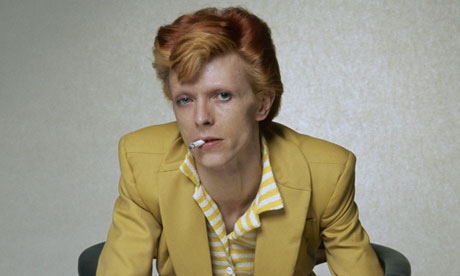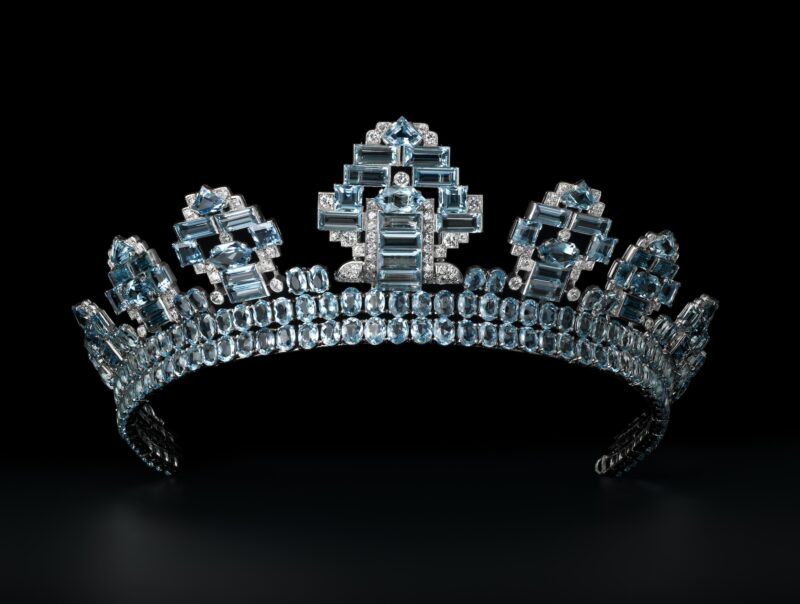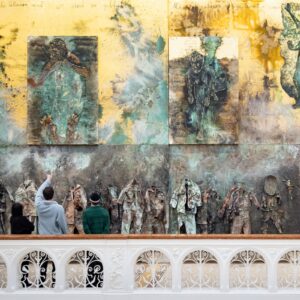
A detail from Terry O’Neill’s photo of David Bowie in 1975. The suit has been cited as an inspiration by Phoebe Philo. Photograph: Terry O’Neill/Getty Images
How much of this exhibition is fashion? David Bowie would probably say that none of it is. Bowie has always said he isn’t interested in fashion, only in wanting his music “to look how it sounds”.
And yet right from the off – a metallic, striped Ziggy Stardust bodysuit designed by Kansai Yamamoto, who in 1971 was the first Japanese designer to show in London – this show is full of clothes that have shaped fashion history, from the Starman leotards, still arresting after all these years, to the turquoise Life on Mars suit and tie, so theatrically slender that it had to be let out by two inches when Kate Moss wore it; from the Aladdin Sane lightning-flash makeup that has inspired a thousand magazine shoots to the sharp-shouldered suits of the Diamond Dogs tour, which were a formative influence on Hedi Slimane, current designer of Yves Saint Laurent.
Displayed alongside that first Ziggy bodysuit is an early video of the artist duo Gilbert & George explaining that, as they see it, “living is one big sculpture”. This is a first principle of Bowie as envisaged here: one of the very first photographs shows him aged 16, with his band the Konrads. His suit and quiff are standard issue for their time, but what makes the image is an instinct for line, silhouette and pose, an innate understanding of how to shape his body for effect.
Image cannot be neatly cordoned off to one side of Bowie. It is part of a three-dimensional experience that David Jones orchestrated for all his characters – not just the Thin White Duke or the Starman, but for David Bowie himself. This show – absorbing, unsettling, full of extraordinary details – captures that sense of immersive experience that makes Bowie electric.
The Bowie fanatics will come here to pay homage to the self-expression of a genius, but what is fascinating for a wider audience is the way Bowie interacts with and shapes popular culture. Whether it’s wearing kitten heels with a Thierry Mugler suit or adopting Japanese silhouettes before that aesthetic was widely known in the west, he articulates and synthesises the avant garde for a mass audience. His ability to be simultaneously androgynous and highly sexual, game-changing in the 1970s, still resonates through popular culture today. Previously unseen footage of the Diamond Dogs tour, (which never came to the UK) shows the extent to which that tour, which required 35 people to build the set each day, invented the idea of the theatrical tour that is now the multimillion-pound stadium pop industry.
The exhibition is sponsored by Gucci, whose designer Frida Giannini is a longtime fan of Bowie, and who recently told Vogue: “Bowie’s shameless androgyny helped women express their masculine strength without losing their feminine glamour and sensuality.” (The sweet irony of a show that celebrates self-expression and the potency of Bowie’s raw, snaggle-toothed type of glamour being sponsored by a global megabrand is a contradiction that seems quite apt.)
Catsuits tend to grab headlines. But from a fashion angle, the true stars of this show are the suits. Bowie’s tailoring is a joy to be savoured. When Slimane moved into his minimalist design studio on taking over Dior menswear, he added just one photo to the white walls, of Bowie in 1975 presenting a Grammy award to Aretha Franklin, wearing a wide-lapelled black suit, white bow tie and black fedora hat. That suit is here. The mustard suit in which Bowie was photographed by Terry O’Neill in 1975 is also here, as is the photograph: the cut is so startling, the tightly waisted jacket and sensual femininity of the balloon-hipped trousers so jarring with the extraordinary Colmans shade and the razor-sharp lapels, that it is easy to see why designer Phoebe Philo cited the suit as an inspiration for a Céline womenswear collection in 2011.
Ziggy Stardust might get top billing but David Bowie, modern dandy, is the most stylish of all the characters on this stage.
guardian.co.uk © Guardian News & Media Limited 2010
Published via the Guardian News Feed plugin for WordPress.







